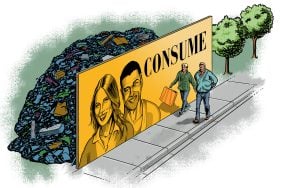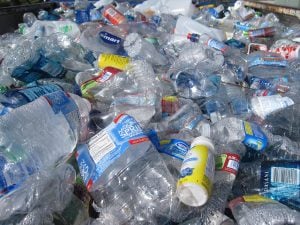
Environment
Canada’s dirty secret
Canada leads the developed world in per capita production of garbage. What’s behind our nation’s wasteful ways?
- 4225 words
- 17 minutes
This article is over 5 years old and may contain outdated information.
Environment

It doesn’t matter if it’s a cell phone, camera, computer, battery powered toy or a washing machine – if it needs electricity it’s e-waste.
According to the United Nations Environmental Programme, up to 90 per cent of global e-waste is illegally traded or dumped each year. With an estimated 50 million tonnes expected to be dumped in 2017, e-waste management is a growing problem. But apart form the huge environmental risk, there’s a criminal one as well.
E-waste isn’t like normal garbage; it’s worth millions. The International Criminal Police Organization, INTERPOL, values a tonne of illegal traded e-waste to be worth about $500USD, which means the illegal e-waste market is worth between $12.5 billion to $18.8 billion USD. Much of the value lies in the metals that are found in the circuits of everyday electronics, such as copper and gold.
According to a UN report, Waste Crimes, Waste Risks: Gaps and Challenges In the Waste Sector, about 64 million people in the developing world make a living scavenging, collecting or recycling e-waste in the developing world. Often it’s dangerous dirty work that not only poses a huge environmental risk, but also serious health risks. Apart from gold, e-waste can contain arsenic, lead, nickel and cobalt, all considered hazardous by the UN. Adding to the problem is that precious metals are often harvested using toxic soups of acids or fire or even mercury.
One Canadian solution that could help to solve the problem is explored in the July 2016 issue of Canadian Geographic. Stephen Foley, a chemistry professor from the University of Saskatchewan, stumbled upon the idea while studying ways to extract gold ore from rocks. Instead of using harmful acids that are hard to dispose, Foley removes gold from e-waste using concentrated vinegar. Not only does it result in more gold recovered than traditional methods, its faster and cheaper. But don’t dig out the vinegar from under the kitchen sink just yet.
Foley says his method isn’t for the backyard hobbyist. “You’d need a good fume hood and the legal technical specs are important too.” Also, the vinegar you have at home is about three to 18 per cent acetic acid. The “vinegar” Foley uses is about 99 per cent. “A downside to our system is that it reeks,” he says. Still, it’s much cheaper and easier to clean than current methods and he hopes to see it used one day.
But even with clever solutions to the e-waste problem such as Foley’s the best thing Canadians can do to help solve the e-waste crisis is to ensure that we dispose of our electronics safely. Check your municipal waste site, or visit the Electronic Products Recycling Association site, to find out how to properly dispose of e-waste in your neighbourhood.
E waste facts:
The amount of global e-waste reached 41.8 million tonnes in 2014, which equals about $52 billion USD of potentially reusable resources
Up to 90% is illegally traded or dumped.
In 2014 Canada produces about 725,000 tonnes of e-waste.
In 2013 Canada’ collected 122, 000 tonnes via “take-back” systems.
The following statistics are the estimated amounts of different types of e-waste generated globally in 2014:
Are you passionate about Canadian geography?
You can support Canadian Geographic in 3 ways:

This story is from the July/August 2016 Issue

Environment
Canada leads the developed world in per capita production of garbage. What’s behind our nation’s wasteful ways?

Environment
David Boyd, a Canadian environmental lawyer and UN Special Rapporteur on Human Rights and the Environment, reveals how recognizing the human right to a healthy environment can spur positive action for the planet

Environment
Myra Hird, a sociology professor at the School of Environmental Studies at Queen’s University in Kingston, Ont., discusses why recycling isn’t a perfect solution

Environment
In a declaration released in advance of this weekend’s G7 summit, more than 40 environmental groups have challenged Canada to achieve zero plastic waste by 2025